Dionysus in Neolithic Europe
Learning from Felix Romuliana Gamzigrad, Serbia and Dionysus Art, Education, Symbols and Signs, Spirituality, defaultAncient Balkans and god Dionysus Cult
Symbols and Signs Research by Nataša Pantović
The so called sacred topography of the Balkans, the northern frontier of the Roman Empire, from the banks of the Danube to the Adriatic Sea, to the south of the Peninsula towards Thessaloniki in Greece, and beyond, towards Malta, Cyprus, Egypt, is the Ancient Europe, hosting most amazing cultures of a number of the oldest advanced civilizations.
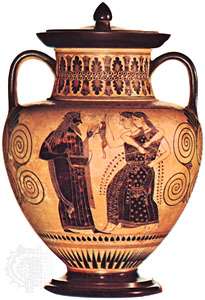
Dionysus and the Maenads amphora by the Amasis Painter 530 BC in Paris
Felix Romuliana, Gamzigrad, Serbia and Dio-NySuS
The village Gamzigrad, 200 AC, is at the banks of the Crni Timok River in Serbia. In 1984 the fragment made of limestone, with an inscription FELIX ROMULIANA, confirmed that Romula’s villa was the memorial of Galerius, co-ruler of Diocletian and Constantine, whose mother was Romulina. Above the village at Magura hill around one kilometre from the main east gate of Romuliana, archaeologists have discovered an ancient grave yard from 300 AC, built on a sacred mound where burial and apotheosis of Galerius’ mother Romula and Galerius himself took place. So the palace, the temples, and the sacred complex was dedicated to Ancient Greek Gods, the emperor and his mother, the post mortal Goddess Romula, who themselves became gods by the consecration act at the mount Magura.
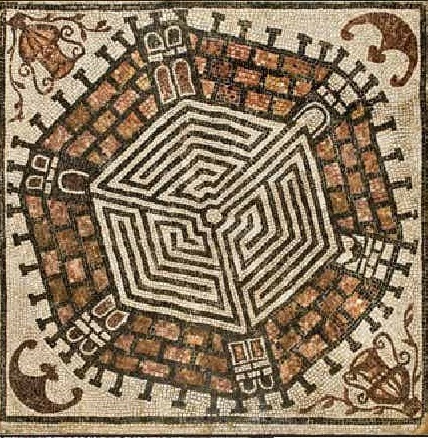
Gamzigrad mosaic of the Ancient Temple Complex-300 AC
Galerius worshiped the god Dionysus and has deified his mother Romula and himself. Dionysus was the ancient god of wine, fertility, theatre, and religious ecstasy. His Roman name was Bacchus. We find him as a God as early as 1500 BC, worshiped by Mycenean Greeks.
“The mosaic representation of Dionysus and the wall relief depicting a sleeping Ariadne symbolize the idea of death – and resurrection, that is, they indicate the two acts of the apotheosis whose impressive material evidence was discovered... The Gamzigrad depiction of Dionysus is the visual representation of this god’s permanent aspiration to bring humans into the world of gods after making them immortal. Dionysus is the saviour of souls and the one who bestows eternal life. Like Dionysus and his mother Semele who joined the gods at the Mount Olympus after Dionysus’ triumphal expedition to India, Galerius, the new Dionysus, and his mother Romula ascended to heaven from the top of Magura hill.”
Maja Živić, Felix Romuliana – Gamzigrad, University of Archaeology, Belgrade, 2011.
The striving for liberation of the Dionysian cult is at the core of Ancient Greek spirituality. It is from the Dionysian rites that the idea of the soul related to the divine and the soul immortality was passed to the Humankind.
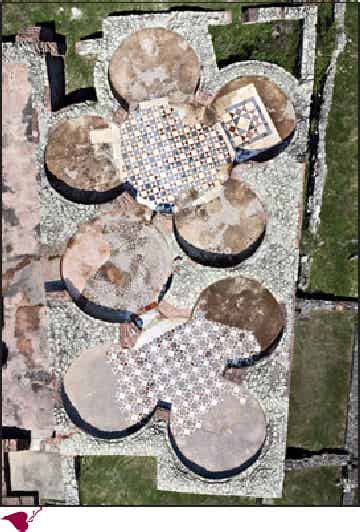
Christian Martyrs about Sirmium and Niš
Two cities, Sirmium (Sremska Mitrovica in Serbia), and Nicaea or Nicea (/naɪˈsiːə/; Greek: Νίκαια, Níkaia) = NiŠ or NiČ, both located in Serbia, are the cities whose wealth, cult and architecture, remind us, mortals, of the time of Balkans wealth and prosperity.
Dušan, my best friend comes from Sirmium (Sremska Mitrovica in Serbia), and he tells me, that while growing up, he used to play digging for gold in the archaeological sites of the area. Believe it or not, kids would collect all sort of ancient jars. Already established in the 1st century AC, it was at its peak during the Diocletian’s persecutions during 303-305 AC, so the city got its nick-name as the city of martyrs. By the way, my niece carries the name of Anastasia, that has left us with a church in Sirmium, and the cult of Anastasia, a young maid who also suffered and died for Christ, in Sirmium, at the beginning of the 4th century AC.
Sirmium was first mentioned in the 4th century BC. It is located on the bank of the river Sava, in the area called Srem of the northern Serbia. The site is today protected as an Archaeological Site of Exceptional Importance. Sirmium had 100,000 inhabitants and was one of the largest cities in Europe of its time. The amount of grain imported between 1 AD and 400 AD was enough to feed 700,000 people
Felix Romuliana Gamzigrad, Serbia
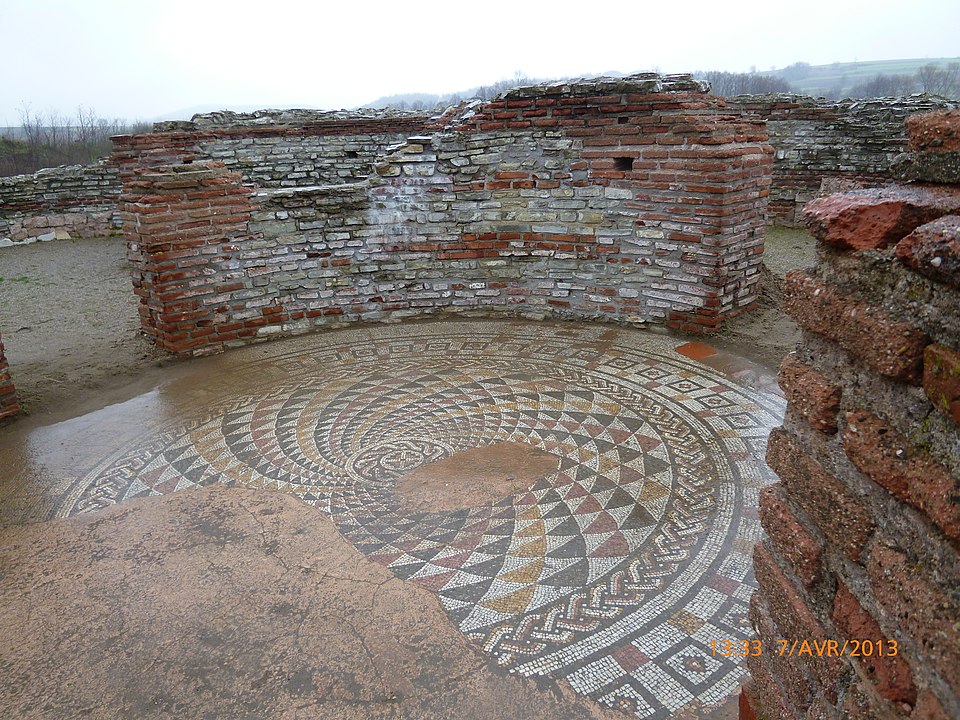
Gamzigrad-Romuliana Palace of Galerius and Temple of Dio-NiSuS
The village Gamzigrad, 200 AC, is at the banks of the Crni Timok River in Serbia. In 1984 the fragment made of limestone,with the inscription FELIX ROMULIANA, confirmed that Romula’s villa was the memorial of Galerius, coruler of Diocletian and Constantine. Above the village at Magura hill around one kilometer from the main east gate of Romuliana, archeologists have recently discovered an ancient grave yard from 300 AC, built on a sacred mound where burial and apotheosis of Galerius’mother Romula and Galerius himself took place. So the palace, the temples, and sacred complex were,dedicated to Ancient Greek Gods, the emperor and his mother, and the post mortal Goddess Romula, who themselves became gods by the consecration act at the mount Magura.
Galerius worshiped Dio-NySuS and has deified his mother Romula and himself creating a temple and a ceremony to support this practice. At the time, an emporer can “qualify” to become “God” or a “Dio”. Apparently it was a better practice, to first deify own mother, so that the divineity of the Empiror is passed by a blood-line.
The floors of the rooms of the Palace and the Temples were paved with precious stone. And under the floors the archeologists found an elaborate system of channels used for heating the entire room. Underfloor Heating! At that time! Wow! The mosaics in the rooms resemble most closly the ones from the 2nd and 1st centuries BC, from the island of Delos.
Northern Temple Gamzigrad
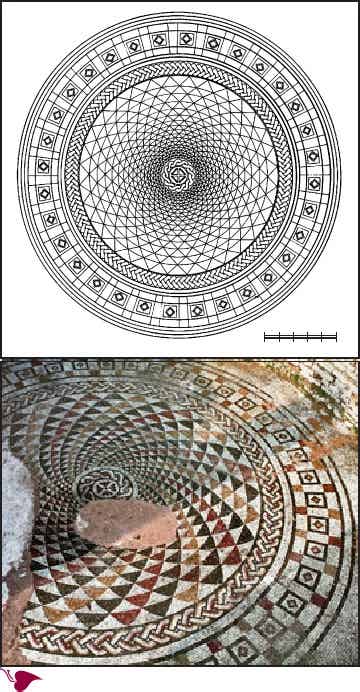
Gamzigrad mosaic of the temple Serbia 300 AC Filix Romula
The temple is similar to the Jupiter temple at Dio-Cletian Palace in Split, built in 305 AD. The remains include a high podium, cross-shaped crypt, stairway and sacrificial altar. It was dedicated to the Goddess Libera
Belief in the triumph of Dionysus was the belief in the cyclical rebirth and.in the return to the Golden Age with Saturn as the divine power.
All the sculptures point to Dionysus / Galerius, and Romula, the ideological concept of the tetrarchy, being the alpha and omega. Jupiter is present at Gamzigrad as the supreme god.
In the spring of 305, Diocletian proclaimed him Augustus in Nicomedia. On the same day, the 1st of May, Constantius who died a year later, was proclaimed Augustus while Galerius’nephew Maximinus was nominated Caesares.
His principal residence before 299 was most likely in Sirmium. He claimed that he was Mars’s son and Romulus’s brother, and that he was begot, like Alexander the Great, by the god himself, who approached his mother Romula in the form of a dragon.
Historical sources tell us that in the winter of 302 AC Galerius stayed in Diocletian’s palace in Nicomedia, to persuade him, under the influence of his mother, to stop the Christians coversions.
The entrance is ornamented with a luxurious mosaic with the image of the Greek god Dio-Nysus. Parts of a sculpture of Galerius depicted as Pantocrator (ruler of Universe) have been found throughout the buildings, a left hand holding a globe of red porphyry.
The other architectural elements are the relief ornaments symbolizing immortality: the picking of grapes, the intertwined vine. The mother, Diva Romula got the temple in the north part of the palace. There were other 2 females living in the estate, the wife Valeria and the daughter Maxi-Milla.
The Palace walls are covered with marble, green porphyry and frescoes. The marble sculptures depicting the Greek gods are made according to 5th and 4th century BC sculptural art.
In the very vicinity of the temple a great number of sculptures of white marble was found, with the most impressive heads of Jupiter and Hercules. The tradition was for the rulers to be named after Jupiter and Hercules and that the annual holiday is set up on the day when the augusti identified themselves with Jupiter and caesari with Hercules – the day which became their birthday (geminus natalis).Ancient Balkans
Ancient European Cities Archaeological Findings dating from 7,000 BC to 400 BC
The following table indicated the major Neolithic Europe cities and the time when they were formed.
|
City |
Country |
7000 - 6000 |
5000 - 4000 |
4000 - 3000 |
3000 – 2000 |
1600 - 1300 |
1000 |
600 |
400 |
|
Athens |
Greece |
|
|
|
|
10000 |
3000 |
100000 |
350000 |
|
Argos |
Greece |
|
|
|
|
|
1000 |
|
30000 |
|
Aegina |
Greek Island |
|
|
|
|
|
|
|
20000 |
|
Akrotiri (Santorini) |
Minoan Greece |
|
|
|
|
15000 |
|
|
|
|
Agrigento |
Sicily, Italy |
|
|
|
|
|
|
|
200000 |
|
Cerveteri |
Rome, Italy |
|
|
|
|
|
|
30000 |
|
|
Choirokoitia |
Cyprus |
2600 |
|
|
|
|
|
|
|
|
Corinth |
Greece |
|
|
|
|
|
|
|
90000 |
|
Crotone |
Sicily, Italy |
|
|
|
|
|
|
|
50000 |
|
Dobrovody |
Ukraine |
|
|
15000 |
|
|
|
|
|
|
Stonehenge |
the UK |
|
|
|
4000 |
|
|
|
|
|
Fedorovka |
Ukraine |
|
6000 |
|
|
|
|
|
|
|
Gournia, Knossos, Malia |
Crete |
|
|
|
1000 |
4000 |
|
|
|
|
Heuneburg |
Danube, Germany |
|
|
|
|
|
|
10000 |
|
|
Ischia |
Island in Italy |
|
|
|
|
|
|
10,000 |
|
|
Knossos |
Crete |
100 |
1000 |
|
1500 |
50000 |
|
|
|
|
Lepenski Vir |
Serbia, Danube |
1000 |
|
|
|
|
|
|
|
|
Mycenae |
Greece |
|
|
|
20000 |
30000 |
|
|
|
|
Manika |
Greece |
|
|
|
10,000 |
|
|
|
|
|
Malta |
Malta |
|
|
|
10,000 |
|
|
|
|
|
Maydanets |
Russia |
|
|
30000 |
|
|
|
|
|
|
Nea Nikomedeia |
Macedonia Greece |
500 |
|
|
|
|
|
|
|
|
Okoliste |
Bosnia & Herzegovina |
|
3000 |
|
|
|
|
|
|
|
Palaikastro |
Crete |
|
|
|
|
18000 |
|
|
|
|
Populonia |
Italy Island |
|
|
|
|
|
|
30000 |
|
|
Tarquinia |
Italy |
|
|
|
|
|
|
25000 |
|
|
Vinča Belo Brdo |
Danube, Belgrade, Serbia |
|
2500 |
|
|
|
|
|
|
|
Veii |
Italy |
|
|
|
|
|
|
40000 |
|
|
Volsinii |
Italy |
|
|
|
|
|
|
|
|
|
Vulci |
Italy |
|
|
|
|
|
|
25000 |
|
|
Sesklo |
Vollos Greece |
300 |
5000 |
|
|
|
|
|
|
|
Sparta |
City State of Ancient Greece |
|
|
|
|
|
|
|
40000 |
|
Syracuse, Sicily |
Sicily, Italy |
|
|
|
|
|
|
|
800000 |
|
Sybaris |
South Italy |
|
|
|
|
|
|
|
200000 |
|
Solnitsata |
Danube, Bulgaria |
|
350 |
|
|
|
|
|
|
|
Tiryns |
Mycanaen Greece |
|
|
|
1,500
|
10000 |
15000 |
|
|
|
Nebelivka |
Ukraine |
|
1700 |
|
|
|
|
|
|
|
Taranto |
South Italy |
|
|
|
|
|
|
|
200,000 |
|
Talianki |
Ukraine |
|
|
20000 |
|
|
|
|
|
|
Thebes, Greece |
Mycanean Greece |
|
|
|
4,000 |
8000 |
|
|
30,000 – 60,000 |
|
Los Millares |
Spain |
|
|
|
2,000 |
|
|
|
|
|
Pavlopetri |
Underwater European city, Greece |
|
|
|
500 |
2000 |
|
|
|
|
Rome |
Italy |
|
|
|
|
|
7000 |
80000 |
130000 |
|
|
|
|
|
|
|
|
|
|
|
|
|
|
|
|
|
|
|
|
|
|
The Largest cities of North Africa and Middle East, Ethiopia, Egypt, Iraq, Syria, Turkey were booming with the cities as early as 3,000 BC. Some examples are:
|
Babylon |
Iraq |
1,700 BC |
60,000 people |
|
Memphis |
Egypt |
3,300 BC |
20,000 people |
|
Çatalhöyük |
Turkey |
6,500 BC |
10,000 people |
Neolithic Euorpe Archaeological Remains and consciousness Research
The archaeological remains found on the Neolithic sites of the Mediterranean area include a script that has stayed within our A-to-SH for 4,000+ years.
Observing the above table of “Roman” territories, I have come across the description of the history of Paris. “Paris, France, was founded around the end of the 3rd century BC by the Gauls who were called Parisii. In 52 BC Julius Caesar's legions conquered the territory, founding the Roman city, Lutetia on the earlier settlement.” Wikipedia, Paris. Interestingly, for some reason we do not call Paris, Roman...
- Ancient Greek Numbers and their Symbols
The Ancient Greek Numerical System Pythagoras Symbols Numbers and Tetractys by Nataša Pantović The divine number, the holy holy Tetractys, we find as a symbol expressi - Dionysus in Neolithic Europe
Ancient Balkans and god Dionysus Cult Symbols and Signs Research by Nataša Pantović The so called sacred topography of the Balkans, the northern frontier of the Roman E - Goddess Axen and Athena
Goddess aXen / Athena and Ancient Egyptian Amarna Heresy Ancient Scripts De-Coding Symbols and Signs research by Nataša Pantović Belief in one God in Ancient Egypt know - The First Language
In Search of the Mother Tongue Script of Neolithic Shamans Research by Nataša Pantović The Archeological Hacilar Settlement of Neolithic Europe dated to 6,000 BC and the - Script of Neolithic Shamans
Researching Ancient Egypt Rosetta Stone and Slavic Cyrilic Symbols and Signs Research by Nataša Pantović Going back to the Egyptian civilization, the ruler of the Med - Sacred Mount Sinai or SHaRa
Jabal, ShaRa or Sinai Ancient Sacred Ground Symbols and Signs Research by Nataša Pantović Jabal, ShaRa or Sinai mountain was always considered particularly sacred JaBaL - Forbidden archaeology
Researching Russion / Serbian Forbidden Neolithic Archeology Symbols and Signs Research by Nataša Pantović In our wish to relate to omnipotent, omniscience, and omnipres - Ancient Egypt Rosetta Stone
Ancient Egypt Sound Č (of Grčka or Greece, mačka or cat, China, or Chill, or Tao Te Ching) Frequencies Symbols and Signs Research by Nataša Pantović Researching Ancient - 21 Symbols Stamps of Neolithic European Archeological Findings
Neolithic European wisdom , symbols and Sound Frequences found in 21 divine Sounds within our Languages Symbols and Signs Research by Nataša Pantović Around one hundre - Sacred Script of Neolithic Europe and Ancient China
Ancient Chinese Philosophy within Neolithic art symbols and spirituality by Nataša Pantović Any discussion of early writing brings up the question of what IS writing





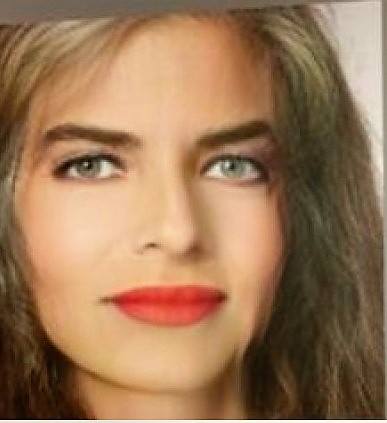
Dionysus in Neolithic Europe No comments on Dionysus in Neolithic Europe: